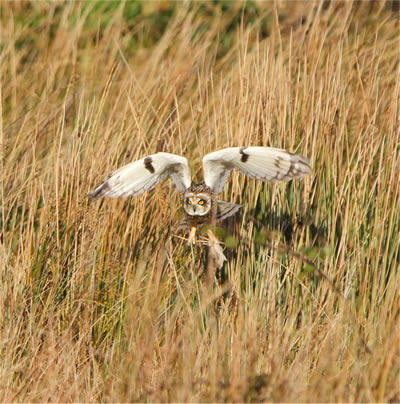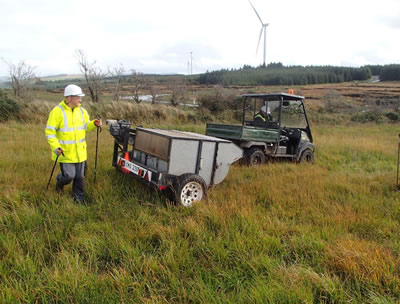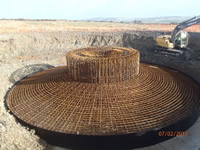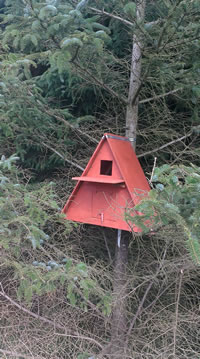SSE Athea Wind Farm, Athea, County Limerick, IrelandConstruction Only Award |
|
Project Team
Client: SSE Renewables
Designers: Malachy Walsh and Partners
Main Contractor: Roadbridge
Nominated Contractors: Powerteam (Substation), Kirby Group (Electrical cabling) and GE Energy (turbine supply & installation).
-------------------------------------------------------------------------------------------------------------------------------------------------------------------------------------
About the Project
The Athea wind farm site is situated approximately 6 km north of the town of Abbeyfeale and close to the village of Athea in West County Limerick. The site stretches across a variety of habitats, including upland blanket bog and heath, coniferous tree plantations and rough agricultural grassland.
The Athea Wind Farm was constructed by Roadbridge on behalf of SSE Renewables. The civil engineering works for this project consisted of the construction of the access roads, hardstands, 16 no. turbine bases, demolition of four existing turbine bases, a substation building, the installation of a permanent met mast and 16 no. GE manufactured wind turbines with a total capacity of 34.35 MW. Work on site began in September 2012 and was completed in February 2014.
Project Environmental & Ecology Management
The Athea wind farm site lies within a Special Protection Area (SPA). This SPA status is due to the presence of the Hen Harrier. Other protected bird species such the short-eared Owl, Merlin and Red Grouse are also found within this SPA.
Because this wind farm is located within a SPA a planning permission condition for the development was that all earthworks were to completely cease from 1st April to 1st September to coincide with the breeding season of the Hen Harrier.
Throughout the project there was a strong emphasis placed on environmental awareness for all working on site. During the site induction all new workers/sub-contractors were given an Eco-Map which was a map of the site showing all the eco-sensitive locations, designated re-fuelling locations and conservations areas. At the back of the map there was brief explanation as to what the site SPA designation means, a picture of the hen harrier to aid recognition and the Environmental Site Rules. The double sided Eco-map was A5 sized and laminated so that a copy of it could be inserted into each hard hat. Throughout the construction phase, there was a programme of ongoing environmental training with the workforce. Each morning, all site workers attended a Pre-Task Briefing where the scheduled tasks for the day were discussed and any environmental controls outlined.
Posters showing pictures of birds of prey were hung up in site offices, the canteen, dying room and on the environmental notice board to increase awareness of what birds to look out for and to report any sightings to the environmental manager.
Hen Harrier usage of the site for hunting/foraging etc was closely monitored and documented by the site ecology team via monthly Vantage Point surveys. On-site sightings of other raptures such as merlins and short-eared owls were also recorded. Transect surveys using tape lures were used to locate the presence of Red Grouse. Standard bird transect surveys were conducted over the summer months. All bird species seen or heard was noted during these surveys.

Figure 1 Short Eared Owl Hunting on Site
Other ecological surveys conducted during the construction phase of this project included bat, small mammal, reptile and habitat surveys. A detailed site wide survey was also conducted to identify the location and quantity of Rhododendron plants on site. These plants, a non-native invasive species, were then cut down and the exposed stems dabbed with an herbicide to kill the root. The elimination of these invasive plants will allow for the re-colonisation of the lands by native plants and shrubs.
The re-instatement of peat layers on mineral sub-soils took place as soon as each turbine base was completed. The majority of these disturbed areas, though initially bare, were naturally re-vegetated within 3 or 4 months. However certain small areas were slower to recover and it was decided that native seed such as purple moor grass would be sown in these areas during the next growing season. As the area is a SPA native seed cannot be brought in from outside the site. Therefore it was necessary to arrange for as a specialist sub-contractor to harvest seed from areas within the site, store for winter and sow the seed in the 2014 growing season.

Figure 2 Harvesting of Purple Grass Seed on Site
Due to the fact that there were several watercourses within the catchment area of the site that were important for salmon and trout spawning a comprehensive water quality monitoring programme was put in place during the construction phase. This included an in-situ continuous monitoring turbidity and pH meter set up in the Knocknasna Stream. This instrument fed live data on line and sent text alerts to site personnel if pre-determined trigger levels were exceeded. Due to the environmental mitigation measures dealing with surface water utilised on the site, these trigger levels were never exceeded.
To enhance the biodiversity of the site several initiatives were put in place. Bird boxes for owls and kestrels and den boxes for pine martens were erected at several locations around the site. An existing borrow pit was reinstated with a small pond incorporated, landscaped and planted with a variety of native tree saplings. Community RelationsTo support the delivery of this project, as is company policy, Roadbridge endeavoured to use local subcontractors and suppliers, where possible. During the course of this project several local community outreach initiatives were put in place. Such initiatives included; donation of labour, plant and materials to support the Athea Tidy Towns Committee in the construction of a new walkway in the local park, a presentation by the site environmental team to the pupils of Athea National primary school on the ecology and biodiversity of the area, which was followed up by a school visit to the site which incorporated a site management presentation to the school children and teachers on the workings of a modern wind farm. The regional branch of the Institute of Engineers of Ireland also visited site for a tour and discussion. A large skip was provided for a week in the village of Athea to allow local residents to dispose of their unwanted electrical and electronic waste. After construction was completed and the compound was being decommissioned, approximately 50 loads of stone from the compound were donated to a local farmer to upgrade some of his access tracks and a machine was provided to assist this work. Waste Minimisation |
|
All earthworks material was reused on site. No earthworks material was sent off-site. A site specific Waste Management Plan was prepared and implemented on this project. The plan set site targets for waste stream segregation, recycling rates and diversions rates from landfill disposal.
Figure 4 Athea National School Site Visit
Analysis of the Site Waste Management Plan Tracker at the end of construction shows that the following was achieved:
-
100% of all oil waste was collected by Hazardous waste contractors for recycling.
-
100% of all batteries were collected in the site offices and sent off site for recycling. Plant hire agreements meant that all plant and vehicle batteries, where changed, were disposed of by lease of hire companies;
-
100% of used printer ink cartridges are boxed up and sent to a Children’s Hospital Charity Organisation.
-
100% of dry recyclable waste was sent for recycling. Dedicated bins were provided in the courtyard for office recycling and skips in the main compound for this propose.
-
100% of timber was reused on site or placed in a dedicated timber skip to be sent off site for recycling by the project’s appointed waste contractor.
The reinforcement steel for each base was delivered by the steel supplier as required to the base. As the exact amount of steel is scheduled for each base there was no waste at each base.
From the construction of the compound at the start of the project, 95% of the structural components required were brought from a previous Roadbridge project. The construction of the site compound is modular in nature which ensures that it can be completely remobilised to the next site with no wastage.
Energy & Natural Resource Management
Roadbridge undertook a Greenhouse Gas Inventory analysis of the project and the findings indicated that there will be a carbon payback period of 2.69 years for this project, thanks to the mitigation measures employed at planning, design and construction phases.
A Green Travel Plan for the project was produced following on from travel to work surveys completed by all site users. As the area was poorly served by public transport carpooling locations were set up, so that co-workers could travel together to and from the site. A private bus was hired to collect workers from surrounding villages to travel to work. Roadbridge, as PSCS for the project, encouraged all other SSER nominated contractors to buy into the energy management initiative for the project. These initiatives were discussed at weekly Interface meetings.
A Rainwater Harvesting Unit was constructed on-site to capture rain run-off from the roof of the main compound. This harvested rainwater was used to supply water for the on-site toilets. This resulted in an average saving of 34m³ of water per month. This low cost innovation has been very effective and is now being implemented across all Roadbridge projects.
The use of timber shuttering on site for the construction of turbine bases was avoided by utilising corriboard shuttering made from 100% recyclables plastic. The use of corriboard meant a reduction in labour, plant, manual handling and waste management costs associated with timber shuttering. The corriboard is simply left in place after the pour is completed.

Figure 5 Use of Corriboard Shuttering at Bases
To what extent did the use of CEEQUAL influence your project?
The CEEQUAL assessment was used to provide a systematic and coherent approach to tracking the management activities and associated sustainability effects of the Athea Wind Farm Project, within the overall framework of best sustainability practice. We used it as a tool to plan sustainability throughout the construction phase.
We chose to go along the Construction Only route for this project due to the fact that the Planning Permission was granted several years ago and the points that would have been lost due to lack of planning around sustainability would have negated the good work being carried during the construction phase, where, as was evidenced from the assessment, a huge emphasis was placed on sustainability. This shows the importance of a project incorporating the principles ingrained in CEEQUAL from concept to completion.


 Figure 3 Bird Boxes Installed on Site
Figure 3 Bird Boxes Installed on Site